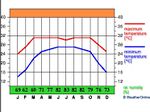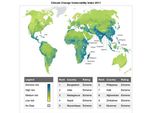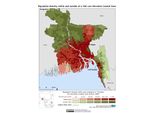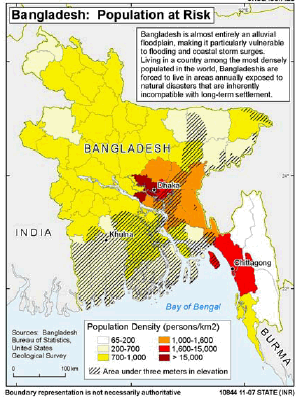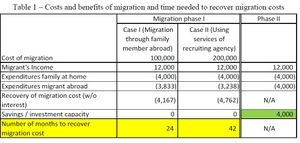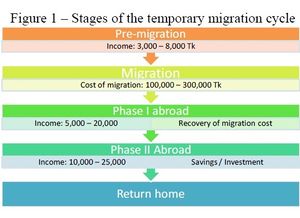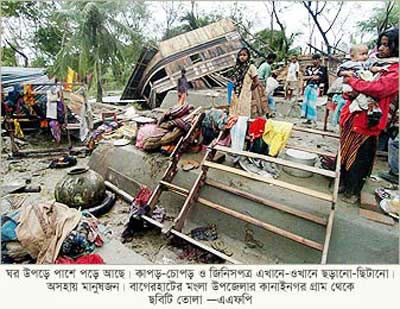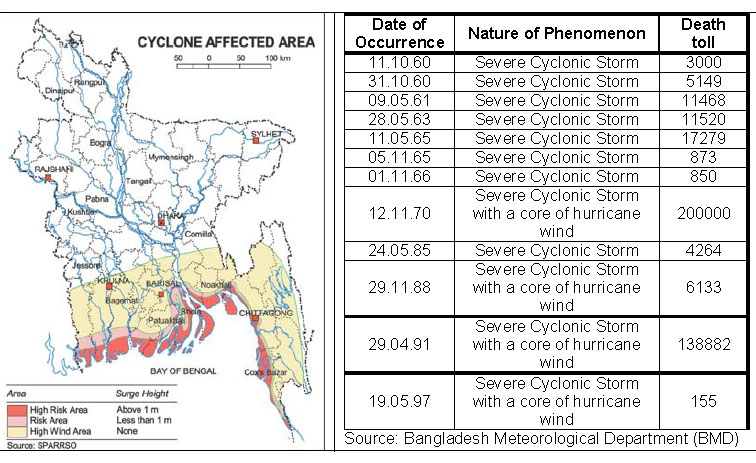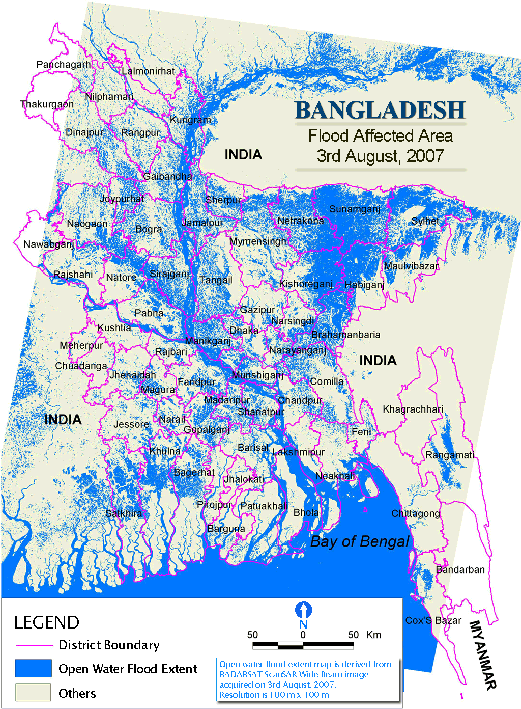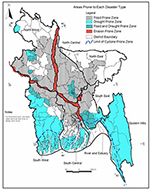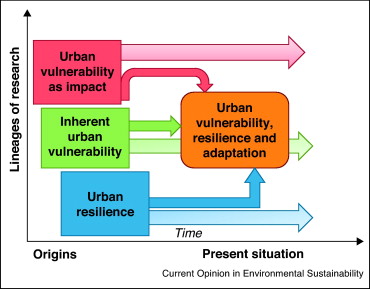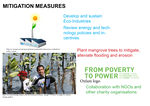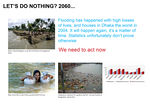Group F - Collaborative Climate Adaption Project: Difference between revisions
No edit summary |
|||
| (99 intermediate revisions by 5 users not shown) | |||
| Line 5: | Line 5: | ||
{| align="right" width="300pt" style="background:Gainsboro; color:black" | {| align="right" width="300pt" style="background:Gainsboro; color:black" | ||
|- | |- | ||
| '''Area''' ||style="background:Lavender"| '' | | '''Area''' ||style="background:Lavender"| ''The city of Dhaka'' | ||
|- | |- | ||
| '''Place''' || style="background:Lavender"|''Dhaka'' | | '''Place''' || style="background:Lavender"|''Dhaka'' | ||
| Line 11: | Line 11: | ||
| '''Country''' || style="background:Lavender"|''Bangladesh'' | | '''Country''' || style="background:Lavender"|''Bangladesh'' | ||
|- | |- | ||
| '''Topic''' || style="background:Lavender"|'' | | '''Topic''' || style="background:Lavender"|''Climate Change Adaptation'' | ||
|- | |- | ||
| ''' | | '''Authors''' || style="background:Lavender"|''Claudia Ferrai, Masoomeh Rajabi and Tanja Helbing'' | ||
|- | |- | ||
| colspan="3" align="center" style="background:silver"| [[File:Riverfinal.jpg|300px]] | | colspan="3" align="center" style="background:silver"| [[File:Riverfinal.jpg|300px]] | ||
| Line 22: | Line 22: | ||
|width=300 | |width=300 | ||
|height=200 | |height=200 | ||
|lat= | |lat=23.766667 | ||
|lng= | |lng=90.383333 | ||
|zoom= | |zoom=8 | ||
|centermarker=yes | |centermarker=yes | ||
|maptypecontrol=yes | |maptypecontrol=yes | ||
| Line 32: | Line 32: | ||
}} | }} | ||
|} | |} | ||
=== Rationale: Why have you selected this case study area? === | === Rationale: Why have you selected this case study area? === | ||
Climate change in Bangladesh is an extremely crucial issue and according to National Geographic, Bangladesh ranks first as the most vulnerable nation to the impacts of climate change in the coming decades. Bangladesh is the most vulnerable nation due to global climate change in the world according to German Watch’s Global Climate Risk Index (CRI) of 2011. Shortage of land to accommodate the people, food security, human health, illiteracy, and so forth. | |||
Dhaka is one of the ten mega-cities in the world. Growing at a very fast rate, the population of Dhaka urban area is predicted to increase to about 21 million by 2015 from the current population of 11.3 million. Dhaka’s rapid development, its fast-changing urban landscape and the associated critical environmental challenges call for holistic urban planning, strengthening of institutions responsible for urban development and good governance. | Dhaka is one of the ten mega-cities in the world. Growing at a very fast rate, the population of Dhaka urban area is predicted to increase to about 21 million by 2015 from the current population of 11.3 million. Dhaka’s rapid development, its fast-changing urban landscape and the associated critical environmental challenges call for holistic urban planning, strengthening of institutions responsible for urban development and good governance. | ||
We have decided to explore the main problems that impact this country. | |||
=== Authors' perspectives === | === Authors' perspectives === | ||
Bangladesh and in particular the city of Dakarta faces a huge challenge in the near future. It has to deal with economical, social and political issues that will aggravate because of climate change. Drastic planning measures need to be taken in order to alleviate the possible future scenario that will occur due to rises in global temperatures. There will be higher risks of flooding, overcrowding will rise, supplying food to all the citizens will be harder and poor health conditions will increase. | |||
Landscape Architects will be able to give planning advise, apply strategies, improve urban design and implement alleviation measures thanks to its interdisciplinary approach. Urgent measures need to be taken and this could be done more rapidly if the local politicials are made aware of the future scenario and if they will ask or be given the appropriate advise by qualified professionals. | |||
=== Landscape and urban context=== | |||
*Biogeography, land use patterns, cultural features, overall character, history and dynamics | |||
* ratio of green/blue and sealed/built-up areas | |||
'''History of Dhaka''' | |||
The first urban settlements in the area, now teh city of Dhaka, date back to the 7th century B.C.. The city area was ruled by the Buddhist kingdom of Kamarupa before passing to the control of the Sena dynasty in the 9th century B.C.. After the Sena dynasty, Dhaka was successively ruled by the Turkish and Afghan governors descending from the Delhi Sultanate before the arrival of the Mughals in 1608. After Mughals, British ruled the region for around 200 years until the independence of Pakistan in 1947. Dhaka became the capital of the East Pakistan province. Since the independence of Bangladesh from West Pakistan in 1971, Dhaka has been the capital of Bangladesh. | |||
'''Flora & Fauna in Bangladesh''' | |||
In bangladesh we can find more than 650 species of birds and the Royal Bengal Tiger. | |||
Along the old Grand Trunk Road lay huge rain trees, and every village is an arboreal oasis, often with the spectacular Banyan called also the shot tree. | |||
Each season produces a variety of flowers; among them, the prolific Water Hyacinth. It craetes a carpet of thick green leaves and blue flowers. Other decorative plants, which are widely spread are Jasmine, Water Lily, Rose, Hibiscus, Bougainvillea, Magnolia, and an incredible diversity of wild orchids in the forested areas. | |||
Bangladesh is home to the Royal Bengal Tiger and others of the cat family, such as leopards and the smaller fishing and jungle cats. Other large animals include Asiatic elephants (mostly migratory herds from India), a few black bears in Chittagong division, wild pigs and deer. Monkeys, languor, gibbons (the only ape in the subcontinent), otters and mongooses are some of the smaller animals. Wild buffalo and rhinoceros were recorded in Bangladesh, but all became extinct in the last century. | |||
'''Urbanization and green space dynamics in Greater Dhaka, Bangladesh''' | |||
Green space is particularly indispensable for proper functioning of the ecosystem in an urban environment. Green spaces in Greater Dhaka are rapidly disappearing over the course of time even though they provide a number of natural, economic and social benefits. The disappearance of green spaces is primarily attributed to a rapid increase in the urban population, mainly driven by rural–urban migration. As a result, the landscape is becoming highly fragmented and less connected. A substantial reduction of green patches is also leading to deterioration of the ecological condition of the landscape. The drastic reduction of green spaces in Greater Dhaka is attributed to a lack of policy, low political motivation, and poor management. In order to ensure sustainability of green spaces and proper functioning of the city’s ecosystem, there is an urgent need for strategic green space planning. | |||
'''Overall character''' | |||
Dhaka City is a fast growing megacity. It is a city of extreme inequality with a stark contrast between the rich and poor. Urban transformation of Dhaka City has created severe pressure on existing infrastructures and its ‘absorbing’ capacities. A significant portion of poor residents are forced to live in a variety of slums and squatter settlements in the city which are mostly vulnerable to flooding, unhealthy environments and diseases, and generally unsuitable for habitation. The city faces serious problems in housing and in almost all areas of its infrastructure like electricity, gas and fuel supply, water supply, sewerage and excreta management, solid waste management and so on. There is little provision of access to social services for health, education and recreation for the urban poor. The frequency and severity of floods and of drainage problems poses serious challenges to city dwellers, more particularly to the urban poor living in slums and squatter settlements. Crime and violence have also developed as serious problems. Culturally the city has emerged as a ‘ruralised’ megacity. The city government of Dhaka has failed to play an effective role in its planning, implementation, administration and management. | |||
'''Land use pattern of Dhaka city''' | |||
Dhaka city started to develop after 1947 mainly from the Pakistan period. The residential and commercial areas developed side by side mainly along the narrow roads as most of the infrastructure facilities where there. Figure 1.4 is shows the land use pattern of Dhaka city in 1995. A mixture of residential, commercial and small industries can be seen in old Dhaka. Motijheel area is considered as a commercial area. Dhanmondi was developed as a pure residential area after the first masterplan of Dhaka city in 1958 but now this area is treated as a mix land use area because of the presence of educational institutes, hospitals, and commercial centres. Dhaka Improvement Trust (DIT) developed Gulshan Model Town. | |||
'''Residential Areas''' | |||
Dhaka is the center of the government and the center of economic power. It shows continuous expansion and shift in terms of residential development. The old city of Dhaka has intensely centralized development with a strong urban core starting from Postogola in east and continued up to Ahsan Manjil near Sadarghat on west. | |||
'''Industrial Areas''' | |||
The origin of Dhaka city has started from the river bank of Buriganga at the south. In the extreme south-east, near Shyampur, Postagola towards Sadarghat, a patch of industrial development has taken place. Tejgaon Industry area and inner zones the readymade Garment Industries. Commercial Areas The commercial land uses are sporadic development all around the city. The Motijheel C.A., Karwan Bazaar are two important commercial areas in Dhaka city. | |||
Table 1.1 is showing the land use pattern of mega city Dhaka where agricultural land is about 47%, residential land is approximately 25%, very little amount like about 3% of vacant land and water bodies about 10%. Most of the water bodies and open spaces are being filled up to build formal and informal housing settlements. | |||
Table 1.2 illustrates the overall situation of open space in Dhaka city Corporation (DCC) | |||
where about 22% of total land is open space. Here open space means land for agricultural, gardening, graveyard, lake, vacant space, park, play ground, pond and swamp. Among them agricultural land has taken major part (about 12%) then vacant land (about 5%). Here agriculture means the rural agriculture in the fringe area of the DCC. The percentage of Recreational place and water bodies is very low which is | |||
negligible for any mega city like Dhaka. | |||
=== Cultural/social/political context=== | === Cultural/social/political context=== | ||
* | * | ||
'''Culture''' | |||
The Bengali culture is a fine blend of its neighbouring countries and the west. The most popular dressing style for women are Sarees or Salwar Kameez. Men usually prefer western clothing. On April 14 ( The bengali new year, also known as Pohela Baishakh ) girls wearing white with red linning (mostly) sarees and men in Punjabi suit cover the streets of Shahbaag, Ramna Park, and The University of Dhaka. Various folk bands and singers from all over the country performs at those street corners, reminding the people of the culture of their nation. Despite the modernization of the capital and the growing popularity of Rock Bands, traditional folk music is still popular in most other parts of the country. | |||
'''Political''' | |||
Bangladesh has experienced different types of government regime. These are: democratic rule (1971-75), military rule and an attempt to return to democracy (1975-81), military rule (1981-1991) and return to multiparty democracy in 1991. In 1991, a major political party was elected through a general election conducted under a care-taker neutral government. But politics in Bangladesh always remain confrontational, one party distrusting and blaming the other when it fails to win election and get power. Elected parliaments have been made ineffective by continuous boycott of parliamentary session by those who are not in power. As a result a “culture of conflict” has developed where the politics of exclusion dominate rather than the politics of inclusion, affecting the total economy and society. Political agitations that take the form of frequent strikes, hartals and blockade cause huge loss to the economy. Recently the magnitude of hartal and blockade has increased significantly. “After a decade of democratic renewal in the 1990s, which succeeded 16 years of cantonment raj, our politics is becoming increasingly dysfunctional. Linguistically, culturally, socially Bangladesh is a homogenous country. People in Bangladesh do not have the freedom to develop themselves according to their choice, and are instead embedded in certain unfreedoms. The removal of substantial unfreedoms is constitutive of development (Sen 2000). There are five different types of rights and opportunities that help to advance the general capability of a person. These are: political freedoms; economic facilities; social opportunities; transparency guarantees and protective security. These are indeed mutually reinforcing and complementary (Sen 2000:10). These unfreedoms are accentuated by the state which fails to play its neutral and benevolent role in providing succour to the people. | |||
'''Sports''' | |||
Cricket is the most passionately followed sport in Bangladesh, and is a favorite pastime for many residents of Dhaka city. Youths can be seen playing in almost every available spot in the city, and often take their games to side streets due to the lack of fields and open areas in the city. Bangladesh was awarded test-playing status in 2002 by the International Cricket Council, and this has added to the popularity of the sport. Dhaka is home to two of the country's biggest sporting clubs, Abahani and Mohammedan. These two clubs have longstanding rivalries in both cricket and soccer, which is arguably the second most keenly followed sport in the country. Chess is the another sports/games category with a lot of success stories. | |||
'''Legal framework''' | |||
Bangladesh’s legal framework for international cooperation in corruption cases consists essentially of the Extradition Act and, to a limited extent, the provisions in the Criminal Procedure Code on evidence commissions. Extradition to and from countries is, however, subject to the existence of a treaty. Until recently, the lack of treaties no doubt presented the greatest obstacle for cooperation. Since the ratification of the UNCAC in 2007, Bangladesh may now seek and provide extradition and MLA to and from States Parties to the Convention. | Bangladesh’s legal framework for international cooperation in corruption cases consists essentially of the Extradition Act and, to a limited extent, the provisions in the Criminal Procedure Code on evidence commissions. Extradition to and from countries is, however, subject to the existence of a treaty. Until recently, the lack of treaties no doubt presented the greatest obstacle for cooperation. Since the ratification of the UNCAC in 2007, Bangladesh may now seek and provide extradition and MLA to and from States Parties to the Convention. | ||
'''Transport''' | |||
First of all, I should say, The transportation system in Dhaka is predominantly road based. However, the roads of Dhaka still occupy only 8% of the total area, even after the implementation of the Dhaka Urban Transport Project (DUTP) and the Dhaka Integrated Transport Project (DITP), whereas ideally at least 25% of the total city area is required as road space to facilitate a smooth transport system in a modern city. | |||
The main mode of transportation in Dhaka city is non-motorized cycle rickshaws. Almost 320,000 rickshaws are run in the Dhaka city every day, of these, 70,000 of them are officially registered , Daily Prothom Alo. Rickshaws have been blamed for causing traffic congestion, and have been banned from some major city roads despite their low cost and low pollution levels. The next important means of transport are public buses. Although the state-owned Bangladesh Road Transport Corporation (BRTC) operates some local and long distance buses there are many (often unregulated) private bus operators such as Salsabeel, Anabeel, Pink, Metrolink, Anik and many other transport companies who provide local bus services as well as premium non-stop bus services between the downtown and the suburbs. Although cheap, these buses are often very crowded. | |||
Before 2002, Dhaka was plagued with pollution from two-stroke 3-wheeler taxis or scooters (locally called Baby Taxi, each carrying about 3 passengers) and human haulers (locally called Tempo, each carried about 10 people). More than 50,000 smoke-emitting taxis polluted the air with carbon-monoxide, lead, and other hazardous compounds. A Government-ban on two-stroke vehicles in 2002 helped clear the air. Since then, the two-stroke taxis have been replaced by four-stroke Green taxis which run on Compressed Natural gas or CNG. A low number of CNG refilling stations created a problem initially, but Government subsidies and allocation of land for such stations have encouraged the establishment of a sufficient number of CNG stations. | |||
=== Local Climate === | === Local Climate === | ||
| Line 69: | Line 113: | ||
*Which changes are expected? Is there any evidence? | *Which changes are expected? Is there any evidence? | ||
The climate of Dhaka is tropical. It characteristics are hot, wet and humid. Dhaka has a distinct monsoon season, with an annual average temperature of 25 °C. The temperature is varying between 18 °C in January and 29 °C in August (diagram below). | The climate of Dhaka is tropical. It characteristics are hot, wet and humid. Dhaka has a distinct monsoon season, with an annual average temperature of 25 °C. The temperature is varying between 18 °C in January and 29 °C in August (diagram below).Bangladesh itself can be divided into three different seasons. Firstly the wet season from end of may till beginning of October. Secondly the cold season from October till the end of February. And thirdly the hot season from mid of march until the middle of may. Beside this classification is the climate divided from the local people into six parts. Basanto (spring), Grishma (summer), Barsha (rain time), Sharat (fall), Hemanto (foggy) und Sheet (winter).Nearly 80% of the average rainfall occurs during the monsoon season which lasts from May till the end of September. Increasing air and water pollution from traffic congestion and industrial waste are serious problems in the city. Affecting public health and the living quality.Water bodies and wetlands are partly destroyed for buildings and other real estate developments Coupled with the mentioned pollution, such erosion of natural habitats threatens to destroy slowly the regional biodiversity. [http://www.iten-online.ch itenonline] According to the climate change vulnerability index from 2011 Bangladesh and therefore Dhaka have an extremely high risk to get affected by the climate change during the next years and decades.The biggest concern for Dhaka will be the impacts of flooding. Especially near to the coast lines where the population density is very high. This leads to massive problems by the case of a flood. Many people could loos there home and working place. Areas for agriculture and feeding will be overflooded and useless. | ||
<gallery caption=" " widths="150px" heights="150px" perrow="5"> | |||
Image:climate 1.jpg|. | |||
Image:climate 2.jpg|. | |||
Image:climate 3.jpg|. | |||
</gallery> | |||
Illustration: Table or time line | |||
=== Analysis of vulnerability === | |||
*If you consider these potential changes - which aspects/functions of your case study would be affected? | |||
According to the climate change vulnerability index from 2011 Bangladesh and therefore Dhaka have an extremely high risk to get affected by the climate change during the next years and decades. | According to the climate change vulnerability index from 2011 Bangladesh and therefore Dhaka have an extremely high risk to get affected by the climate change during the next years and decades. | ||
The biggest concern for Dhaka will be the impacts of flooding. Especially near to the coast lines where the population density is very high. This leads to massive problems by the case of a flood. Many people could lose their home and working place. Areas for agriculture will be overflooded and useless. | |||
'''Analysis of Vulneability''' | |||
Bangladesh is one of the most climate vulnerable countries in the world and will become even more so as a result of climate change. Floods, tropical cyclones, storm surges and droughts are likely to become more frequent and severe in the coming years. It experiences frequent natural disasters, which cause loss of life (see Box 1), damage to infrastructure and economic assets, and adversely impacts on lives and livelihoods, especially of poor people. The Intergovernmental Panel on Climate Change (IPCC) predicts that global temperatures will rise between 1.8 C and 4.0 C by the last decade of the 21st century . | |||
'''Climate hazards in BANGLADESH''' | |||
Bangladesh is susceptible to floods, tropical cyclones, storm surges, and droughts. The regions of the country affected by these different hazards are shown in Map 1. | |||
[[File:2EE4F0A4B3660924852573C5006BDAA8_0.gif|300px]] | |||
[[File:Untitled_1.jpg|300px]] | |||
[[File:Untitled.jpg|300px]] | |||
[[File:Untitlepd.jpg|300px]] | |||
=== Proposals for Climate Change Adaption === | === Proposals for Climate Change Adaption === | ||
To suggest an adaptation proposal for the climate change in Dhaka, it is vital to consider the context of the country Bangladesh itself. Bangladesh is a country with a low income. Despite the fact that the national poverty rate stays relatively the same, is the urban poverty slightly rising. Many people, especially in urban areas are living in slums. In the future this way of living will be rising through the climate change. | |||
[[File:climate change adaptation-copy.jpeg|600px]] | |||
=== Proposals for Climate Change Mitigation === | === Proposals for Climate Change Mitigation === | ||
| Line 103: | Line 154: | ||
* Please describe 2-3 measures | * Please describe 2-3 measures | ||
'''What is ‘Mitigation’?''' | |||
Mitigation refers to efforts to reduce greenhouse gas emissions‟ (Huq, 2006). Mitigation may also refer to efforts to capture greenhouse gases through certain kinds of land use, such as tree plantation. This will reduce global warming, as the greenhouse layer in the atmosphere will not be so thick and its warming, blanket-like effect will be lessened. | |||
Mitigation is the main response that must be made to prevent future impacts of climate change. It consists of measures such as switching from using coal, to petrol/oil, to natural gas, which are progressively better in terms of greenhouse gas emissions. Natural gas is the least polluting fossil fuel. Better still is the use of renewable sources of energy (Huq, 2006). | |||
'''Mitigation Action in Bangladesh''' | |||
It has been said that no single organisation or country can solve the problem of climate change. It would be foolish and arrogant to pretend otherwise. But we can make a difference by making a start and showing what is possible (Lord Browne, 2002). So while some of the issues may seem remote and organisations like the Church of Bangladesh unable to engage directly; for example in cutting US emissions, nobody is helpless there is always something to be done and examples to be set. Advocacy and lobbying others abroad is important but action is also necessary in Bangladesh. | |||
Bishop Sarker (2007) has pointed out that although Bangladesh may not be the guiltiest in terms of climate change emissions; the country is now „following blindly the Western ideology and technology for their development‟, just as India has. Orissa state‟s power stations in India, emitted 164 million tonnes of carbon dioxide in 2005, equal to the total emitted in the whole of India in 1996 and it will emit 3% of global emissions after new planned plants are opened (Das, 2006). China has also shown the negative impact a non-western country with a large population can have when it develops in the wrong way, as it recently become the world‟s largest emitter of greenhouse gasses, opening numerous coal fired power stations to provide energy for industry (Gore, 2006). China is now the second and India the fourth largest producers of greenhouse gases from their power generation sectors, emitting 2.7 billion and 583 million tonnes of greenhouse gasses per year (Vidal, 2007). | |||
Bangladesh must not follow the same damaging route; it has too much to lose. In particular advocacy by civil society should call for a rethink in regards to the country exploiting its coal reserves in the face of energy shortages, for alternative greener alternatives should be pursued instead. The necessary forced relocation of 40,000 of people in the area of the proposed Phulbari mine should also count against such a plan (Gain, 2007). So there is an important role for NGOs in influencing the development process in Bangladesh to follow an environmentally sustainable path in this and many other ways. | |||
Bangladesh has about 30,000 industrial units: 24,000 small and cottage sized and 6,000 large and medium sized factories. These have a very poor environmental record (Gain, 2002a). These must be pressured by civil society directly and through government to improve their energy efficiency, dispose of waste properly and to reduce emissions. | |||
Houghton (2007) quotes Edmund Burke, a British Member of Parliament 200 years ago who said: “No one made a greater mistake than he who did nothing because he could do so little”. Bangladesh may be a small country, the Church of Bangladesh a small organisation, with beneficiaries and staff just individuals. But all have the opportunity to make an impact that will reduce the impact of global warming, however small; it is a moral choice for good everyone must take. If many people take action the combined impact becomes big. | |||
Even though Bangladesh's contribution to the generation of greenhouse gases is miniscule, Bangladesh wishes to play its part in reducing emissions now and in the future. The Government of Bangladesh emphasises energy efficiency as well as renewable energy development, particularly solar homes and biogas plants. In recent | |||
years, in partnership with civil society, it has implemented a major nationwide programme of social forestry and has planted coastal 'greenbelts' as a key adaptation-mitigation strategy. As we industrialise and develop our coal reserves, we will seek the transfer of state-of-the-art technologies from developed countries to ensure that we follow a low-carbon growth path. Bangladesh is also committed to reducing greenhouse gas emissions from agriculture and urban waste management. | |||
Currently, Bangladesh has two Clean Development Mechanism (CDM) projects concerned with solar energy and waste management. We look forward to increasing the number of similar programmes and experimenting with new instruments to generate carbon credits and facilitate carbon market financing in the future. | |||
'''Green House Gas(GHG)Emission and Mitigation,''' | |||
Bangladesh's contribution to emission of green house gas (GHG) is miniscule. In 2005, the total GHG emissions from Annex 1 parties was 18.2 billion tonnes of CO equivalent (excluding Land Use, Land Use Change and Forestry -LULUCF). Including LULUCF, it was 16.7 billion tonnes CO equivalent. In contrast, the 122 non-Annex 1 parties | |||
emitted a total of 11.9 billion tonnes (with LUCF) and 11.7 (without LUCF). Bangladesh emitted only 0.053 to 0.045 billion tonnes (with or without LUCF) - less than one-fifth of one percent of world total - reflecting its extremely low consumption of energy. | |||
Bangladesh is a low energy-consuming but energy-starved country. Its energy consumption in 2004-05 was 89 kg per capita. Only Nepal, among its neighbors in South Asia, consumes less energy on a per capita basis. Despite the low level of energy use, the country is unable to meet even the present demand for energy. This demand is likely to rise at least 50 percent faster GDP per capita in coming years. These figures indicate why energy security is a fundamental issue of development in Bangladesh. While there is scope to raise efficiency in production and consumption of energy, thus lowering GHG emissions, such activities must not jeopardise the legitimate demand for and supply of energy. | |||
The other major sources of GHG emission in Bangladesh are methane from flooded rice fields and waste,particularly in urban areas. Raising irrigation and water use efficiency through improved agronomic practices and proper waste management is likely to lower emissions of methane from these sources. | |||
'''Mitigation and low Carbon development''' | |||
Even though Bangladesh's contribution to the generation of greenhouse gases is very low, we wish to play our part in reducing emissions now and in the future. Under this pillar we will: | |||
Develop a strategic energy plan and investment portfolio to ensure national energy security and lower greenhouse gas emissions Expand the social forestry programme on government and community lands throughout the country Expand the 'greenbelt' coastal afforestation programme with mangrove planting along the shoreline Seek the transfer of state-of the art technologies from developed countries to ensure that we follow a low-carbon growth path (e.g., 'clean coal' and other technologies). | |||
Review energy and technology policies and incentives and revise these, where necessary, to promote efficient production, consumption, distribution and use of energy. | |||
=== Dhaka in 2060 === | |||
Considering the current trends in temperatures and rainfalls, there is a high possibility that most of Dhaka will be swept away from flooding, heavy rainfalls and rise in water levels. The coastline will be completely different and most of the settlements will not be there. | |||
There are been in the past already signs of these trends as we can see also from the tables below. | |||
[[File:17_nov_07_prothom-alo2_jpg.jpg]][[File:DhakaTable1.jpg]] | |||
[[File:fl-2007_1024.gif]][[File:bangla_hazard01.JPG]] | |||
=== What can be generalized from this case study? === | === What can be generalized from this case study? === | ||
Food for thought | |||
The effect of climate change in poor areas and with tropical climate can have dramatic effect. The lack of resources (economical, intellectual and technical) urges even more to take action now. | |||
Simple measures, like planting mangrove trees can have great impact in term of climate change mitigation in 10 years to come. These simple and relatively economical means need to be communicated effectively and with urgency to the actual politicians so they can be done. Communication, distribution of knowledge through organizations like NGOs is essential. Local context needs to be explored firstly before measures can be done. For many people living in settlements is a way of life that has strong social and cultural significance. Unfortunately many of these settlements are in the most vulnerable areas for example of flooding. There is a perception that just moving them will solve the problem but as we are starting to learn from researches, this is not the case. Moving people to another contexts (social, environmental and cultural) leads to other problems, mostly social problems. Settlements need to be researched in order to help these people. Climate change is also social. | |||
Migrating people after these disasters has also a huge cost that could have been avoided at a less price (human and economical, see Oxfam link below) is climate change measures would have been taken. Something needs to happen now. | |||
Some questions | |||
How can a country that it is not able to feed its own population deal with climate change? | |||
Are we able to identify cheap/local adaptive measures? How can these be effectively used? | |||
What do we know of settlers in low flood plains? Do we have the right just to move them? Can we learn from them? | |||
[[File:1-s2.0-S1877343511000030-gr2.jpg]] | |||
[[File:Dhaka is the second most vulnerable city to coastal flooding among nine coastal cities built on river deltas, a study suggests 1.jpeg]] | |||
=== Presentation Slides === | |||
<gallery caption=" " widths="150px" heights="150px" perrow="5"> | <gallery caption=" " widths="150px" heights="150px" perrow="5"> | ||
Image: | Image:presentation.jpg|DHAKA (BANGLADESH) AND ITS CLIMATE VULNERABILITIES | Slide One | ||
Image: | Image:presentation2.jpg|MITIGATION MEASURES | Slide Two | ||
Image:presentation3.jpg|LET’S DO NOTHING? 2060... | Slide Three | |||
Image: | |||
</gallery> | </gallery> | ||
=== References === | === References === | ||
---- | ---- | ||
[[Category:Climate Change Case Study]] | [[Category:Climate Change Case Study]] | ||
{{#widget:WidgetName|param1=value1|param2=value2}} | {{#widget:WidgetName|param1=value1|param2=value2}} | ||
DHAKA METROPOLITAN DEVELOPMENT PLAN STRATEGIC ENVIRONMENTAL ASSESSMENT | |||
Prepared by: SENES Consultants Limited In association with Bangladesh Country Review History of State-NSP relations, Professor S. M. Nurul Alam | |||
Physical Density and Urban Sprawl:A Case of Dhaka City, Md. Syful Islam | |||
LAND USE CHANGE PREDICTION IN DHAKA CITY USING GIS AIDED | |||
MARKOV CHAIN MODELING,Md. Shahidul Islam* Raquib Ahmed,Institute of Environmental Science, University of Rajshahi, Rajshahi 6205, | |||
http://www.travelbd.com/flora_fauna.htm , | |||
http://en.wikipedia.org/wiki/History_of_Dhaka , | |||
http://dhakadailyphoto.blogspot.nl/p/history-heritage.html , | |||
http://www.lonelyplanet.com , | |||
http://www.travelbd.com , | |||
http://encycl.opentopia.com/term/Dhaka , | |||
http://www.oxfamblogs.org/fp2p/?p=7905 , | |||
National Geographic http://ngm.nationalgeographic.com/2011/05/bangladesh/belt-text , | |||
Watch’s Global Climate Risk Index (CRI)2011 | |||
Project Number: 44305-01 Capacity Development Technical Assistance (CDTA)June 2011,People’s Republic of Bangladesh: Support for Climate, | |||
Change Mitigation and Renewable Energy Development, | |||
Ministry of Environment and Forests Government of the People's Republic of Bangladesh,Published by:Ministry of Environment and Forests, | |||
Government of the People's Republic of Bangladesh Published in:September 2008 Dhaka, Bangladesh, | |||
Iftekhar, S. EVALUATION OF MANAGEMENT STRATEGIES OF COASTAL FORESTS IN BANGLADESH. http://www.aseanbiodiversity.info/Abstract/52001421.pdf, | |||
Climate Change and Poverty in Urban Bangladesh (ClimUrb) Dr Manoj Roy , | |||
BANGLADESH CLIMATE CHANGE STRATEGY AND ACTION PLAN2008(Published by:Ministry of Environment and Forests Government of the People's Republic of Bangladesh), | |||
Physical Density and Urban Sprawl: A Case of Dhaka City Md. Syful IslamSyful_1978@yahoo.com, | |||
Latest revision as of 10:17, 4 August 2013
| Area | The city of Dhaka | |
| Place | Dhaka | |
| Country | Bangladesh | |
| Topic | Climate Change Adaptation | |
| Authors | Claudia Ferrai, Masoomeh Rajabi and Tanja Helbing | |
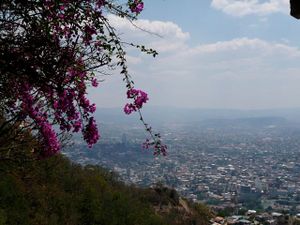
| ||
|
| ||
Rationale: Why have you selected this case study area?
Climate change in Bangladesh is an extremely crucial issue and according to National Geographic, Bangladesh ranks first as the most vulnerable nation to the impacts of climate change in the coming decades. Bangladesh is the most vulnerable nation due to global climate change in the world according to German Watch’s Global Climate Risk Index (CRI) of 2011. Shortage of land to accommodate the people, food security, human health, illiteracy, and so forth. Dhaka is one of the ten mega-cities in the world. Growing at a very fast rate, the population of Dhaka urban area is predicted to increase to about 21 million by 2015 from the current population of 11.3 million. Dhaka’s rapid development, its fast-changing urban landscape and the associated critical environmental challenges call for holistic urban planning, strengthening of institutions responsible for urban development and good governance. We have decided to explore the main problems that impact this country.
Authors' perspectives
Bangladesh and in particular the city of Dakarta faces a huge challenge in the near future. It has to deal with economical, social and political issues that will aggravate because of climate change. Drastic planning measures need to be taken in order to alleviate the possible future scenario that will occur due to rises in global temperatures. There will be higher risks of flooding, overcrowding will rise, supplying food to all the citizens will be harder and poor health conditions will increase. Landscape Architects will be able to give planning advise, apply strategies, improve urban design and implement alleviation measures thanks to its interdisciplinary approach. Urgent measures need to be taken and this could be done more rapidly if the local politicials are made aware of the future scenario and if they will ask or be given the appropriate advise by qualified professionals.
Landscape and urban context
- Biogeography, land use patterns, cultural features, overall character, history and dynamics
- ratio of green/blue and sealed/built-up areas
History of Dhaka The first urban settlements in the area, now teh city of Dhaka, date back to the 7th century B.C.. The city area was ruled by the Buddhist kingdom of Kamarupa before passing to the control of the Sena dynasty in the 9th century B.C.. After the Sena dynasty, Dhaka was successively ruled by the Turkish and Afghan governors descending from the Delhi Sultanate before the arrival of the Mughals in 1608. After Mughals, British ruled the region for around 200 years until the independence of Pakistan in 1947. Dhaka became the capital of the East Pakistan province. Since the independence of Bangladesh from West Pakistan in 1971, Dhaka has been the capital of Bangladesh.
Flora & Fauna in Bangladesh
In bangladesh we can find more than 650 species of birds and the Royal Bengal Tiger. Along the old Grand Trunk Road lay huge rain trees, and every village is an arboreal oasis, often with the spectacular Banyan called also the shot tree.
Each season produces a variety of flowers; among them, the prolific Water Hyacinth. It craetes a carpet of thick green leaves and blue flowers. Other decorative plants, which are widely spread are Jasmine, Water Lily, Rose, Hibiscus, Bougainvillea, Magnolia, and an incredible diversity of wild orchids in the forested areas.
Bangladesh is home to the Royal Bengal Tiger and others of the cat family, such as leopards and the smaller fishing and jungle cats. Other large animals include Asiatic elephants (mostly migratory herds from India), a few black bears in Chittagong division, wild pigs and deer. Monkeys, languor, gibbons (the only ape in the subcontinent), otters and mongooses are some of the smaller animals. Wild buffalo and rhinoceros were recorded in Bangladesh, but all became extinct in the last century.
Urbanization and green space dynamics in Greater Dhaka, Bangladesh
Green space is particularly indispensable for proper functioning of the ecosystem in an urban environment. Green spaces in Greater Dhaka are rapidly disappearing over the course of time even though they provide a number of natural, economic and social benefits. The disappearance of green spaces is primarily attributed to a rapid increase in the urban population, mainly driven by rural–urban migration. As a result, the landscape is becoming highly fragmented and less connected. A substantial reduction of green patches is also leading to deterioration of the ecological condition of the landscape. The drastic reduction of green spaces in Greater Dhaka is attributed to a lack of policy, low political motivation, and poor management. In order to ensure sustainability of green spaces and proper functioning of the city’s ecosystem, there is an urgent need for strategic green space planning.
Overall character
Dhaka City is a fast growing megacity. It is a city of extreme inequality with a stark contrast between the rich and poor. Urban transformation of Dhaka City has created severe pressure on existing infrastructures and its ‘absorbing’ capacities. A significant portion of poor residents are forced to live in a variety of slums and squatter settlements in the city which are mostly vulnerable to flooding, unhealthy environments and diseases, and generally unsuitable for habitation. The city faces serious problems in housing and in almost all areas of its infrastructure like electricity, gas and fuel supply, water supply, sewerage and excreta management, solid waste management and so on. There is little provision of access to social services for health, education and recreation for the urban poor. The frequency and severity of floods and of drainage problems poses serious challenges to city dwellers, more particularly to the urban poor living in slums and squatter settlements. Crime and violence have also developed as serious problems. Culturally the city has emerged as a ‘ruralised’ megacity. The city government of Dhaka has failed to play an effective role in its planning, implementation, administration and management.
Land use pattern of Dhaka city
Dhaka city started to develop after 1947 mainly from the Pakistan period. The residential and commercial areas developed side by side mainly along the narrow roads as most of the infrastructure facilities where there. Figure 1.4 is shows the land use pattern of Dhaka city in 1995. A mixture of residential, commercial and small industries can be seen in old Dhaka. Motijheel area is considered as a commercial area. Dhanmondi was developed as a pure residential area after the first masterplan of Dhaka city in 1958 but now this area is treated as a mix land use area because of the presence of educational institutes, hospitals, and commercial centres. Dhaka Improvement Trust (DIT) developed Gulshan Model Town.
Residential Areas
Dhaka is the center of the government and the center of economic power. It shows continuous expansion and shift in terms of residential development. The old city of Dhaka has intensely centralized development with a strong urban core starting from Postogola in east and continued up to Ahsan Manjil near Sadarghat on west.
Industrial Areas
The origin of Dhaka city has started from the river bank of Buriganga at the south. In the extreme south-east, near Shyampur, Postagola towards Sadarghat, a patch of industrial development has taken place. Tejgaon Industry area and inner zones the readymade Garment Industries. Commercial Areas The commercial land uses are sporadic development all around the city. The Motijheel C.A., Karwan Bazaar are two important commercial areas in Dhaka city.
Table 1.1 is showing the land use pattern of mega city Dhaka where agricultural land is about 47%, residential land is approximately 25%, very little amount like about 3% of vacant land and water bodies about 10%. Most of the water bodies and open spaces are being filled up to build formal and informal housing settlements. Table 1.2 illustrates the overall situation of open space in Dhaka city Corporation (DCC) where about 22% of total land is open space. Here open space means land for agricultural, gardening, graveyard, lake, vacant space, park, play ground, pond and swamp. Among them agricultural land has taken major part (about 12%) then vacant land (about 5%). Here agriculture means the rural agriculture in the fringe area of the DCC. The percentage of Recreational place and water bodies is very low which is negligible for any mega city like Dhaka.
Cultural/social/political context
Culture
The Bengali culture is a fine blend of its neighbouring countries and the west. The most popular dressing style for women are Sarees or Salwar Kameez. Men usually prefer western clothing. On April 14 ( The bengali new year, also known as Pohela Baishakh ) girls wearing white with red linning (mostly) sarees and men in Punjabi suit cover the streets of Shahbaag, Ramna Park, and The University of Dhaka. Various folk bands and singers from all over the country performs at those street corners, reminding the people of the culture of their nation. Despite the modernization of the capital and the growing popularity of Rock Bands, traditional folk music is still popular in most other parts of the country.
Political
Bangladesh has experienced different types of government regime. These are: democratic rule (1971-75), military rule and an attempt to return to democracy (1975-81), military rule (1981-1991) and return to multiparty democracy in 1991. In 1991, a major political party was elected through a general election conducted under a care-taker neutral government. But politics in Bangladesh always remain confrontational, one party distrusting and blaming the other when it fails to win election and get power. Elected parliaments have been made ineffective by continuous boycott of parliamentary session by those who are not in power. As a result a “culture of conflict” has developed where the politics of exclusion dominate rather than the politics of inclusion, affecting the total economy and society. Political agitations that take the form of frequent strikes, hartals and blockade cause huge loss to the economy. Recently the magnitude of hartal and blockade has increased significantly. “After a decade of democratic renewal in the 1990s, which succeeded 16 years of cantonment raj, our politics is becoming increasingly dysfunctional. Linguistically, culturally, socially Bangladesh is a homogenous country. People in Bangladesh do not have the freedom to develop themselves according to their choice, and are instead embedded in certain unfreedoms. The removal of substantial unfreedoms is constitutive of development (Sen 2000). There are five different types of rights and opportunities that help to advance the general capability of a person. These are: political freedoms; economic facilities; social opportunities; transparency guarantees and protective security. These are indeed mutually reinforcing and complementary (Sen 2000:10). These unfreedoms are accentuated by the state which fails to play its neutral and benevolent role in providing succour to the people.
Sports
Cricket is the most passionately followed sport in Bangladesh, and is a favorite pastime for many residents of Dhaka city. Youths can be seen playing in almost every available spot in the city, and often take their games to side streets due to the lack of fields and open areas in the city. Bangladesh was awarded test-playing status in 2002 by the International Cricket Council, and this has added to the popularity of the sport. Dhaka is home to two of the country's biggest sporting clubs, Abahani and Mohammedan. These two clubs have longstanding rivalries in both cricket and soccer, which is arguably the second most keenly followed sport in the country. Chess is the another sports/games category with a lot of success stories.
Legal framework
Bangladesh’s legal framework for international cooperation in corruption cases consists essentially of the Extradition Act and, to a limited extent, the provisions in the Criminal Procedure Code on evidence commissions. Extradition to and from countries is, however, subject to the existence of a treaty. Until recently, the lack of treaties no doubt presented the greatest obstacle for cooperation. Since the ratification of the UNCAC in 2007, Bangladesh may now seek and provide extradition and MLA to and from States Parties to the Convention.
Transport
First of all, I should say, The transportation system in Dhaka is predominantly road based. However, the roads of Dhaka still occupy only 8% of the total area, even after the implementation of the Dhaka Urban Transport Project (DUTP) and the Dhaka Integrated Transport Project (DITP), whereas ideally at least 25% of the total city area is required as road space to facilitate a smooth transport system in a modern city. The main mode of transportation in Dhaka city is non-motorized cycle rickshaws. Almost 320,000 rickshaws are run in the Dhaka city every day, of these, 70,000 of them are officially registered , Daily Prothom Alo. Rickshaws have been blamed for causing traffic congestion, and have been banned from some major city roads despite their low cost and low pollution levels. The next important means of transport are public buses. Although the state-owned Bangladesh Road Transport Corporation (BRTC) operates some local and long distance buses there are many (often unregulated) private bus operators such as Salsabeel, Anabeel, Pink, Metrolink, Anik and many other transport companies who provide local bus services as well as premium non-stop bus services between the downtown and the suburbs. Although cheap, these buses are often very crowded. Before 2002, Dhaka was plagued with pollution from two-stroke 3-wheeler taxis or scooters (locally called Baby Taxi, each carrying about 3 passengers) and human haulers (locally called Tempo, each carried about 10 people). More than 50,000 smoke-emitting taxis polluted the air with carbon-monoxide, lead, and other hazardous compounds. A Government-ban on two-stroke vehicles in 2002 helped clear the air. Since then, the two-stroke taxis have been replaced by four-stroke Green taxis which run on Compressed Natural gas or CNG. A low number of CNG refilling stations created a problem initially, but Government subsidies and allocation of land for such stations have encouraged the establishment of a sufficient number of CNG stations.
Local Climate
- What are the climatic conditions at present? Have there been extreme weather events in the near past?
- Which changes are expected? Is there any evidence?
The climate of Dhaka is tropical. It characteristics are hot, wet and humid. Dhaka has a distinct monsoon season, with an annual average temperature of 25 °C. The temperature is varying between 18 °C in January and 29 °C in August (diagram below).Bangladesh itself can be divided into three different seasons. Firstly the wet season from end of may till beginning of October. Secondly the cold season from October till the end of February. And thirdly the hot season from mid of march until the middle of may. Beside this classification is the climate divided from the local people into six parts. Basanto (spring), Grishma (summer), Barsha (rain time), Sharat (fall), Hemanto (foggy) und Sheet (winter).Nearly 80% of the average rainfall occurs during the monsoon season which lasts from May till the end of September. Increasing air and water pollution from traffic congestion and industrial waste are serious problems in the city. Affecting public health and the living quality.Water bodies and wetlands are partly destroyed for buildings and other real estate developments Coupled with the mentioned pollution, such erosion of natural habitats threatens to destroy slowly the regional biodiversity. itenonline According to the climate change vulnerability index from 2011 Bangladesh and therefore Dhaka have an extremely high risk to get affected by the climate change during the next years and decades.The biggest concern for Dhaka will be the impacts of flooding. Especially near to the coast lines where the population density is very high. This leads to massive problems by the case of a flood. Many people could loos there home and working place. Areas for agriculture and feeding will be overflooded and useless.
Illustration: Table or time line
Analysis of vulnerability
- If you consider these potential changes - which aspects/functions of your case study would be affected?
According to the climate change vulnerability index from 2011 Bangladesh and therefore Dhaka have an extremely high risk to get affected by the climate change during the next years and decades.
The biggest concern for Dhaka will be the impacts of flooding. Especially near to the coast lines where the population density is very high. This leads to massive problems by the case of a flood. Many people could lose their home and working place. Areas for agriculture will be overflooded and useless.
Analysis of Vulneability
Bangladesh is one of the most climate vulnerable countries in the world and will become even more so as a result of climate change. Floods, tropical cyclones, storm surges and droughts are likely to become more frequent and severe in the coming years. It experiences frequent natural disasters, which cause loss of life (see Box 1), damage to infrastructure and economic assets, and adversely impacts on lives and livelihoods, especially of poor people. The Intergovernmental Panel on Climate Change (IPCC) predicts that global temperatures will rise between 1.8 C and 4.0 C by the last decade of the 21st century .
Climate hazards in BANGLADESH
Bangladesh is susceptible to floods, tropical cyclones, storm surges, and droughts. The regions of the country affected by these different hazards are shown in Map 1.
Proposals for Climate Change Adaption
To suggest an adaptation proposal for the climate change in Dhaka, it is vital to consider the context of the country Bangladesh itself. Bangladesh is a country with a low income. Despite the fact that the national poverty rate stays relatively the same, is the urban poverty slightly rising. Many people, especially in urban areas are living in slums. In the future this way of living will be rising through the climate change.
Proposals for Climate Change Mitigation
- Which measures would need to be taken to reduce greenhouse gas emissions and other drivers of climate change within your case study area?
- How could you assure sustainability of these measures?
- Please describe 2-3 measures
What is ‘Mitigation’?
Mitigation refers to efforts to reduce greenhouse gas emissions‟ (Huq, 2006). Mitigation may also refer to efforts to capture greenhouse gases through certain kinds of land use, such as tree plantation. This will reduce global warming, as the greenhouse layer in the atmosphere will not be so thick and its warming, blanket-like effect will be lessened.
Mitigation is the main response that must be made to prevent future impacts of climate change. It consists of measures such as switching from using coal, to petrol/oil, to natural gas, which are progressively better in terms of greenhouse gas emissions. Natural gas is the least polluting fossil fuel. Better still is the use of renewable sources of energy (Huq, 2006).
Mitigation Action in Bangladesh
It has been said that no single organisation or country can solve the problem of climate change. It would be foolish and arrogant to pretend otherwise. But we can make a difference by making a start and showing what is possible (Lord Browne, 2002). So while some of the issues may seem remote and organisations like the Church of Bangladesh unable to engage directly; for example in cutting US emissions, nobody is helpless there is always something to be done and examples to be set. Advocacy and lobbying others abroad is important but action is also necessary in Bangladesh.
Bishop Sarker (2007) has pointed out that although Bangladesh may not be the guiltiest in terms of climate change emissions; the country is now „following blindly the Western ideology and technology for their development‟, just as India has. Orissa state‟s power stations in India, emitted 164 million tonnes of carbon dioxide in 2005, equal to the total emitted in the whole of India in 1996 and it will emit 3% of global emissions after new planned plants are opened (Das, 2006). China has also shown the negative impact a non-western country with a large population can have when it develops in the wrong way, as it recently become the world‟s largest emitter of greenhouse gasses, opening numerous coal fired power stations to provide energy for industry (Gore, 2006). China is now the second and India the fourth largest producers of greenhouse gases from their power generation sectors, emitting 2.7 billion and 583 million tonnes of greenhouse gasses per year (Vidal, 2007).
Bangladesh must not follow the same damaging route; it has too much to lose. In particular advocacy by civil society should call for a rethink in regards to the country exploiting its coal reserves in the face of energy shortages, for alternative greener alternatives should be pursued instead. The necessary forced relocation of 40,000 of people in the area of the proposed Phulbari mine should also count against such a plan (Gain, 2007). So there is an important role for NGOs in influencing the development process in Bangladesh to follow an environmentally sustainable path in this and many other ways.
Bangladesh has about 30,000 industrial units: 24,000 small and cottage sized and 6,000 large and medium sized factories. These have a very poor environmental record (Gain, 2002a). These must be pressured by civil society directly and through government to improve their energy efficiency, dispose of waste properly and to reduce emissions.
Houghton (2007) quotes Edmund Burke, a British Member of Parliament 200 years ago who said: “No one made a greater mistake than he who did nothing because he could do so little”. Bangladesh may be a small country, the Church of Bangladesh a small organisation, with beneficiaries and staff just individuals. But all have the opportunity to make an impact that will reduce the impact of global warming, however small; it is a moral choice for good everyone must take. If many people take action the combined impact becomes big.
Even though Bangladesh's contribution to the generation of greenhouse gases is miniscule, Bangladesh wishes to play its part in reducing emissions now and in the future. The Government of Bangladesh emphasises energy efficiency as well as renewable energy development, particularly solar homes and biogas plants. In recent years, in partnership with civil society, it has implemented a major nationwide programme of social forestry and has planted coastal 'greenbelts' as a key adaptation-mitigation strategy. As we industrialise and develop our coal reserves, we will seek the transfer of state-of-the-art technologies from developed countries to ensure that we follow a low-carbon growth path. Bangladesh is also committed to reducing greenhouse gas emissions from agriculture and urban waste management. Currently, Bangladesh has two Clean Development Mechanism (CDM) projects concerned with solar energy and waste management. We look forward to increasing the number of similar programmes and experimenting with new instruments to generate carbon credits and facilitate carbon market financing in the future.
Green House Gas(GHG)Emission and Mitigation,
Bangladesh's contribution to emission of green house gas (GHG) is miniscule. In 2005, the total GHG emissions from Annex 1 parties was 18.2 billion tonnes of CO equivalent (excluding Land Use, Land Use Change and Forestry -LULUCF). Including LULUCF, it was 16.7 billion tonnes CO equivalent. In contrast, the 122 non-Annex 1 parties emitted a total of 11.9 billion tonnes (with LUCF) and 11.7 (without LUCF). Bangladesh emitted only 0.053 to 0.045 billion tonnes (with or without LUCF) - less than one-fifth of one percent of world total - reflecting its extremely low consumption of energy.
Bangladesh is a low energy-consuming but energy-starved country. Its energy consumption in 2004-05 was 89 kg per capita. Only Nepal, among its neighbors in South Asia, consumes less energy on a per capita basis. Despite the low level of energy use, the country is unable to meet even the present demand for energy. This demand is likely to rise at least 50 percent faster GDP per capita in coming years. These figures indicate why energy security is a fundamental issue of development in Bangladesh. While there is scope to raise efficiency in production and consumption of energy, thus lowering GHG emissions, such activities must not jeopardise the legitimate demand for and supply of energy. The other major sources of GHG emission in Bangladesh are methane from flooded rice fields and waste,particularly in urban areas. Raising irrigation and water use efficiency through improved agronomic practices and proper waste management is likely to lower emissions of methane from these sources.
Mitigation and low Carbon development
Even though Bangladesh's contribution to the generation of greenhouse gases is very low, we wish to play our part in reducing emissions now and in the future. Under this pillar we will:
Develop a strategic energy plan and investment portfolio to ensure national energy security and lower greenhouse gas emissions Expand the social forestry programme on government and community lands throughout the country Expand the 'greenbelt' coastal afforestation programme with mangrove planting along the shoreline Seek the transfer of state-of the art technologies from developed countries to ensure that we follow a low-carbon growth path (e.g., 'clean coal' and other technologies).
Review energy and technology policies and incentives and revise these, where necessary, to promote efficient production, consumption, distribution and use of energy.
Dhaka in 2060
Considering the current trends in temperatures and rainfalls, there is a high possibility that most of Dhaka will be swept away from flooding, heavy rainfalls and rise in water levels. The coastline will be completely different and most of the settlements will not be there. There are been in the past already signs of these trends as we can see also from the tables below.
What can be generalized from this case study?
Food for thought
The effect of climate change in poor areas and with tropical climate can have dramatic effect. The lack of resources (economical, intellectual and technical) urges even more to take action now. Simple measures, like planting mangrove trees can have great impact in term of climate change mitigation in 10 years to come. These simple and relatively economical means need to be communicated effectively and with urgency to the actual politicians so they can be done. Communication, distribution of knowledge through organizations like NGOs is essential. Local context needs to be explored firstly before measures can be done. For many people living in settlements is a way of life that has strong social and cultural significance. Unfortunately many of these settlements are in the most vulnerable areas for example of flooding. There is a perception that just moving them will solve the problem but as we are starting to learn from researches, this is not the case. Moving people to another contexts (social, environmental and cultural) leads to other problems, mostly social problems. Settlements need to be researched in order to help these people. Climate change is also social. Migrating people after these disasters has also a huge cost that could have been avoided at a less price (human and economical, see Oxfam link below) is climate change measures would have been taken. Something needs to happen now.
Some questions
How can a country that it is not able to feed its own population deal with climate change? Are we able to identify cheap/local adaptive measures? How can these be effectively used? What do we know of settlers in low flood plains? Do we have the right just to move them? Can we learn from them?
Presentation Slides
References
DHAKA METROPOLITAN DEVELOPMENT PLAN STRATEGIC ENVIRONMENTAL ASSESSMENT
Prepared by: SENES Consultants Limited In association with Bangladesh Country Review History of State-NSP relations, Professor S. M. Nurul Alam Physical Density and Urban Sprawl:A Case of Dhaka City, Md. Syful Islam
LAND USE CHANGE PREDICTION IN DHAKA CITY USING GIS AIDED
MARKOV CHAIN MODELING,Md. Shahidul Islam* Raquib Ahmed,Institute of Environmental Science, University of Rajshahi, Rajshahi 6205,
http://www.travelbd.com/flora_fauna.htm ,
http://en.wikipedia.org/wiki/History_of_Dhaka ,
http://dhakadailyphoto.blogspot.nl/p/history-heritage.html ,
http://encycl.opentopia.com/term/Dhaka , http://www.oxfamblogs.org/fp2p/?p=7905 ,
National Geographic http://ngm.nationalgeographic.com/2011/05/bangladesh/belt-text ,
Watch’s Global Climate Risk Index (CRI)2011 Project Number: 44305-01 Capacity Development Technical Assistance (CDTA)June 2011,People’s Republic of Bangladesh: Support for Climate, Change Mitigation and Renewable Energy Development, Ministry of Environment and Forests Government of the People's Republic of Bangladesh,Published by:Ministry of Environment and Forests, Government of the People's Republic of Bangladesh Published in:September 2008 Dhaka, Bangladesh, Iftekhar, S. EVALUATION OF MANAGEMENT STRATEGIES OF COASTAL FORESTS IN BANGLADESH. http://www.aseanbiodiversity.info/Abstract/52001421.pdf, Climate Change and Poverty in Urban Bangladesh (ClimUrb) Dr Manoj Roy , BANGLADESH CLIMATE CHANGE STRATEGY AND ACTION PLAN2008(Published by:Ministry of Environment and Forests Government of the People's Republic of Bangladesh), Physical Density and Urban Sprawl: A Case of Dhaka City Md. Syful IslamSyful_1978@yahoo.com,
